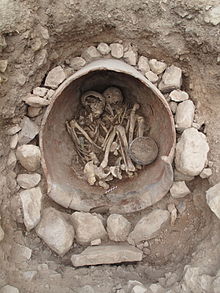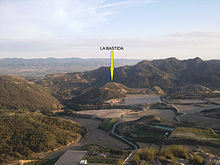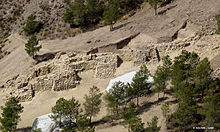La Bastida de Totana
La Bastida de Totana is an archaeological dig near Totana in the Murcia region ofsoutheastern Spain. It is considered one of the most important cities and necropolis of the El Argar culture and was added to the list of protected cultural assets on October 19, 2005as a Bien de Interés Cultural .
location
It is strategically located on the upper steep slope of Mount Gordo, about six kilometers west of Totana. As Roberto Risch explained, this location is a trademark of the El Argar culture. In contrast to the rather poor settlements in agriculturally used, fertile valley plains, their centers of power are positioned on mountains, which in turn are surrounded by even higher mountain ranges.
description
La Bastida de Totana is described as an archaeological sensation by the directors of the excavation, Vicente Lull , Rafael Micó , Cristina Rihuete and Roberto Risch, because there the remains of the first urban hilltop settlement and planned fortifications in Spain in the transition period from the Copper to the Bronze Age are revealed could become. Given the size of the entire complex of over five hectares, it was probably one of the largest cities in Europe when it was founded. Some newspaper articles also write about “ Europe's Troy ”.
The settlement has not yet been completely uncovered, but the finds can already be used to identify districts within the originally up to six meter high sandstone city walls. Based on the fortification wall, defensive-military considerations are assumed. Thanks to a terrace system, the settlement extended up to a height of 375 m above sea level. M. and is considered to be one of the largest in the El Argar culture. It is believed that in addition to private buildings there are also public facilities such as B. was a facility for the collection, storage and distribution of drinking water.
Important finds

Typical of the El Argar culture are the burials of the dead inside the houses or the enclosure. Graves have also been found in Bastida de Totana which, through the grave goods, provide information about the socio-economic position of the buried, since, in contrast to the previous Chalcolithic, these are the first individual graves . In addition, the latter, as well as the location of the grave, could provide information about the different social status of the residents of the respective districts.
In addition to the actual finds, their arrangement gives reason for the hypothesis that specific jobs have been found. For example, metallurgical workshops can be verified here using crucibles and casting molds .
Specifically, in addition to the buildings and graves themselves:
- Loom weights
- Ceramics, such as storage containers, cups and bowls
- Tools made of clay, ceramics, metal and animal bones
- Weapons such as swords, axes and daggers
- Bronze trophies
history
The excavations show three construction phases within the hilltop settlement, which in the 600 years of its existence has never been expanded beyond the defense system that has existed since it was founded. The planning of the fortification preceded the foundation of the city in the early late Neolithic .
The habitation and development is divided into three phases:
- Phase 1 (approx. 2200–2000 B.C.E.)
- Phase 2 (approx. 2000-1850 B.C.E.)
- Phase 3 (approx. 1850–1600 / 1550 B.C.E.)
Research excavations began at the end of the 19th century. The two archaeologists Francisco Jordá Cerdá and John Davies Evans worked there around 1950.
literature
- Vicente Lull , Rafael Micó , Cristina Rihuete-Herrada and Roberto Risch : La Bastida - A Bronze Age city fortification in the western Mediterranean . Accompanying volume for the special exhibition in the State History in the State Museum for Prehistory Halle. Publisher, 2016.
- Martin Bastelheim : Grave equipment as a status indicator ? Thoughts on the social structure of the El Artar culture in southern Spain . Freiberg, University research on prehistoric archeology Volume 121, 2005, Verlag Dr. Rudolf Habelt GmbH, Bonn.
Web links
- Proyecto La Bastida website , visited on May 29, 2016
- Virtual reconstruction
- Website of the Society of Friends of La Bastdia de Sonata Archaeological Site (Spanish) , accessed April 7, 2016
Individual evidence
- ↑ Harald Meller meets Roberto Risch
- ↑ a b c Lull u. a. P. 307
- ↑ Maju: La Bastida de Totana (Spain) may have been largest city in Bronze Age mainland Europe , September 2007, [1]
- ↑ IL M: “Las murrallas de La Bastida solo son comparables con las de Troya”, September 25, 2012, archived copy ( memento of the original from April 8, 2016 in the Internet Archive ) Info: The archive link was inserted automatically and has not yet been checked . Please check the original and archive link according to the instructions and then remove this notice.
- ↑ Lull et al. a. P. 308
- ↑ Bastelheim p. 599
- ↑ Bastelheim p. 600
- ↑ Power and metal in the 3rd and 2nd millennium BC in the southeast of the Iberian Peninsula, Vicente Lull, Rafael Micó, Cristina Rihuete Herrada and Roberto Risch, conferences of the State Museum of Prehistory in Halle • VOLUME 05 • 2010
- ↑ a b 6th Montelius Lecture, June 26, 2014 Early state formation in El Argar (SO Spain, 2200-1550 cal BCE), Roberto Risch, annual report of the Institute for Archaeological Sciences for the academic year 2013–2014
- ^ Digging in the archives: Re-discovering the excavations of John D. Evans . Todd Whitelaw, July 10, 2012, http://www.dayofarchaeology.com/tag/lisa-fentress/
Coordinates: 37 ° 45 ′ 37.1 ″ N , 1 ° 33 ′ 37.4 ″ W.


